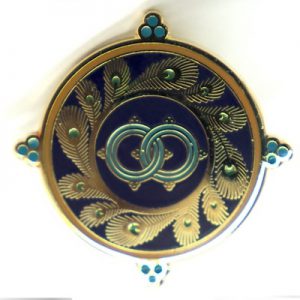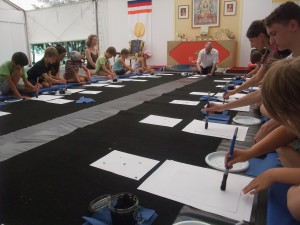Wednesday
Community ArticlesShambhala Is A Culture
Contemplating culture and decorum in Chicago
 Throughout Shambhala, a member of the leadership team at every center worldwide holds the position of Delegate to the Office of Culture & Decorum. Generally, this person is appointed by the director of the international office via nomination from the local council. For Chicago, I am the current nominee. But if you asked me just one year ago to consider this leadership role, I would have laughed out loud.
Throughout Shambhala, a member of the leadership team at every center worldwide holds the position of Delegate to the Office of Culture & Decorum. Generally, this person is appointed by the director of the international office via nomination from the local council. For Chicago, I am the current nominee. But if you asked me just one year ago to consider this leadership role, I would have laughed out loud.
In my 9-year practice journey, my interactions with the Culture & Decorum delegate weren’t pleasant to me. I found encounters to be very stiff and harsh, as if the person’s only job was to shush people in the meditation hall, and to know by heart the order of toasts at a community party. And if such a person genuinely was interested in a more collaborative and relaxed approach to Culture & Decorum, that person left the post with more stress than when they began.
After great contemplation on the teachings of the lineage, my personal experience, and the words of the Sakyong and the Sakyong Wangmo, I have come to see this post as a challenge and opportunity, one that I wish to direct and share with the entire Chicago community. The result of my contemplations comes from a personal exploration of what culture and decorum means in Shambhala.
“Shambhala is a culture. Our vision takes form not only through meditation and study, but also through society and the dignity of culture.”
The Sakyong Wangmo, Khandro Tseyang
Practice On & Off the Cushion
As mindfulness, awareness, and basic goodness are the foundation for our practice on the cushion and in the world, decorum is the practice of communicating mindfulness and awareness to self and others. Through rituals of decorum, we learn to embody our practice and develop habits to support it. So as much as this does include limiting discursive speech in the meditation hall, it also includes practices of generosity, gratitude, exertion, and more.
This isn’t just at the Center, but also at home. Throughout the Way of Shambhala curriculum and beyond, opportunities to practice decorum at home, at work, and in society are available and open to all. Again, the practice of decorum is in service to our personal mindfulness practice and our journey toward discovering basic goodness.
The Language of Basic Goodness
Culture in Shambhala is slightly different. My experience of culture in Shambhala comes through senior teachers and community events. There are dances, toasts, speeches, rituals, songs, and arts that in part are derived from both the native Tibetan culture of Chögyam Trungpa Rinpoche and traditions he adopted during his sojourn in Great Britain. As a Black working-class American, I found it difficult to connect to these cultural displays. I remember times in which I resisted and resented them.
During my most recent retreat, I had a moving experience of Shambhala culture in action, in progress, and in collaborative development. A participant offered during a celebration her own a capella gospel arrangement of a Shambhala root text. It was executed with musical precision, and brought the whole room to joyful tears. That moment softened my rigid view of culture in Shambhala, and revealed the infinite possibilities of enlightened culture.
All secular and religious societies uphold and share what is most important to them through culture. In Shambhala, with basic goodness of self, society and reality as the view, path, and fruition of all actions, culture serves as an expression of basic goodness. Culture is how we personally and publicly acknowledge basic goodness in all things. Weddings, funerals, rites of passage, songs, stories, and the arts express recognition of basic goodness.
As we practice in service to enlightened society and expand our society through space and time, we will inevitably include other expressions of basic goodness in the world that will be equally celebrated and propagated; drum circles, open mics, quinceañeras, mitzvahs, retirements, recovery, balls, dinners, gospel choirs, and so much more are ripe for inclusion in Shambhala culture. They would not at all be appropriated, but rather recognized that in a society as diverse as enlightened society, all expressions of basic goodness are equally practiced and valued.
Opportunities in Chicago
With these understandings, I hunger for the possibilities awaiting the Chicago center. But I can’t do it alone. Through my felt sense of the teachings and community, I can only share what I know. I offer my time and heart to sharing, and to hear how our members personally practice mindfulness everywhere and express basic goodness in the world.
I’d like to cultivate a small, diverse team of leaders who fearlessly model Shambhala culture and decorum, and who wish to expand the bounds of those expressions. If you have any curiosity about this, please contact me. I’m not seeking “perfect practitioners.” I’m not seeking “inflexible hall monitors.” I’m seeking community members who are (nearly) willing to take their practice beyond the cushion, and who want to be challenged. This challenge doesn’t need to be rigorous, but it has so great an opportunity to be joyful!
If you’d like some clarity on what’s in place so far, please seek the following resources:
Books
- An Introduction to Shambhala Culture, distributed by Shambhala Media
- The Lost Art of Good Conversation by Sakyong Mipham
Online resources (requires Shambhala login)
 Akiba Barberousse is the Chicago Center nominee for Delegate to the Office of Culture & Decorum.
Akiba Barberousse is the Chicago Center nominee for Delegate to the Office of Culture & Decorum.







Feb 23, 2018
Reply
Such vision. So exciting. So overdue. So radical. So ordinary. So good. Thank you, Akiba, for your service.
Feb 19, 2018
Reply
To Linda and EMB,
Thank you for your comments and support.
I attended a local retreat that involved icebreaker games. Everyone standing in a circle tossing balls to each other. I could not participate because of my physical condition. I was definitely peeved, especially because it heightened the feeling of being left out and I already feel left out on a daily basis.
There is a long-time sangha member that is connected to us that I wish I could see more, but the member is also physically unable to make it to most events we have. And the member doesn’t live very close to other members.
As the sangha ages, I would have thought that a lot of this inclusion and disability stuff was figured out some time ago, but I see that it isn’t. That’s NOT across the board, as I have been offered accommodations when asked (shout out to SMC!). But unfortunately most people don’t think about it until it directly affects them. That’s why I think a registration field should be added for programs and events on the SDB. Local centers may have their own way of keeping track of it, but having it out there for all would be a good reminder that we need to be mindful of others’ barriers to participation.
I’m rambling now. But what ideas would you suggest for the sangha to more fully integrate inclusivity and disabilities? Feel free to email me if you want: [email protected]
Feb 19, 2018
Reply
Thank you, Nicki!
Feb 19, 2018
Reply
Hi Leda,
As a disabled person myself, I see the same issues. It’s kind of sad that when there is an event, there is no place in the SDB to ask for necessary accommodations. When I created the Awaken Chicago registration page from scratch outside of the SDB, I very much had a place to mark accommodations, and walked most of the venues to make sure that we could indeed make those accommodations when necessary.
I just had a talk on Saturday with the SHWB co-director about this. We will definitely work on it. Thank you for keeping the needs of all people in mind!
Feb 16, 2018
Reply
There is often a conflict between inclusion and forms, especially where disabilities are Involved!
Feb 16, 2018
Reply
Yippee Akiba! As a white person who has always tried to hold equity and celebration of diversity in my heart, I am overjoyed to hear of your post and your intentions for it. Forms can be beautiful, but when done to a level of uptightness, where exclusion of others and well-being of the sangha is not taken into account, people are failing to comprehend the love inherent in these practices. Leda’s experience shows that despite several statements and formal policies about inclusion, we have a ways to go as a truly enlightened culture that takes these statements and policies to heart. I believe the Sakyong should read Leda’s comments, as I believe he would honor those experiences, as might our founding leader. Sadly, I am not anywhere near Chicago, but am wishing you the best in your endeavors. Blessings to you Akiba!
Feb 15, 2018
Reply
Beautiful article, beautiful vision.
(And to Leda in Boulder…let me help you ensure that you get a good seat..Nicki)
Feb 14, 2018
Reply
I am not sure how things happen in Chicago, but what Culture and Decorum has been for me here in Boulder is a rigid way of observing hierarchy. When an important event happens, it feels like the whole shrine room is saved for all sorts of “dignitaries”. No space left for those who don’t qualify as such!! When you are hard of hearing, you have to really request again and again from a frazzled Culture and Decorum representative a seat closer to the speaker in order to be able to hear anything at all. Sometimes this request is honored graciously, sometimes it is not. To me that’s what Culture and Decorum has ended up being. I dread going to events, especially when the Sakyong is going to be there. Instead of looking forward to them, I am afraid to even go as I know that I won’t hear a thing!! All I would like to say to you, please, work closely with the Health and Well-being representative to help people who are handicapped in a non-obvious way.Your article is wonderful and inspiring to me. May your term go smoothly and may you get a lot of help so that a rigid hierarchy does not take the place of basic goodness and human decency. Thank you for your article, Happy Shambhala Day (and Valentine’s Day, too).